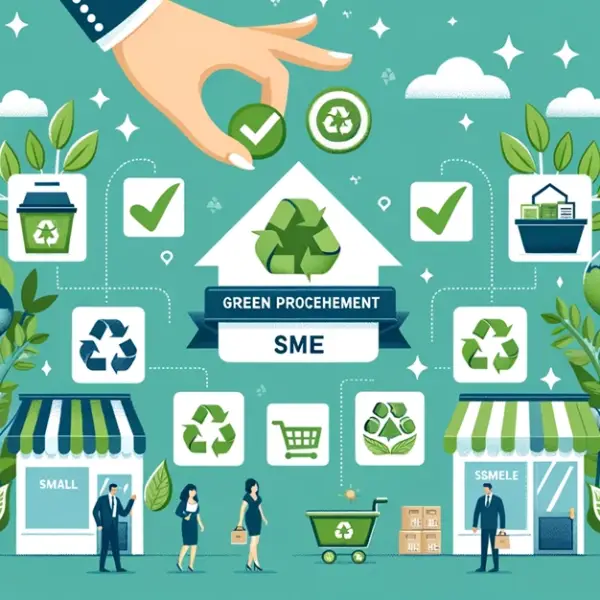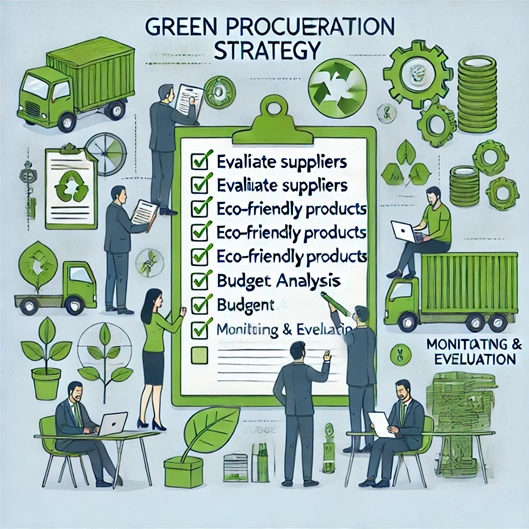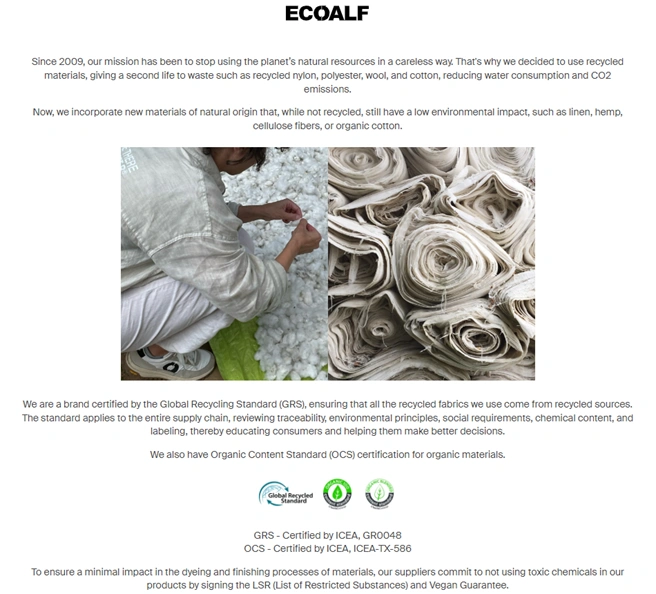Developing a Green Procurement Strategy for SMEs

Knowledge
- Understand the core principles and importance of green procurement.
- Identify key criteria and standards for evaluating suppliers' environmental performance.
- Recognize various eco-friendly products and services that have a reduced environmental impact.
- Learn about budget considerations, including cost categories, potential savings, and financial incentives for sustainable practices.
Skills
- Conduct comprehensive research using academic databases and government/NGO websites.
- Develop clear and concise green procurement policies using document processing tools.
- Create checklists and rubrics for evaluating suppliers based on environmental performance.
- Perform budget analysis using financial planning tools like Excel or Google Sheets.
- Use performance tracking tools like KPI dashboards to monitor sustainability metrics.
- Engage stakeholders through effective communication plans, training sessions, and workshops.
Responsibility & Autonomy
- Take responsibility for developing and implementing a green procurement Strategy that aligns with an SME’s environmental objectives.
- Lead initiatives to engage suppliers, employees, customers, and the community in sustainable practices.
- Demonstrate autonomy in conducting research and synthesizing information into practical guidelines.

As you dive into this task, you will explore the core ideas of green procurement and develop a comprehensive Strategy tailored for small and medium-sized enterprises (SMEs).
To undertake this journey, it will be necessary to define procurement budgets’ constraints, examine regional supply chain structures, and grasp the profound ecological consequences of implementing green procurement approaches.
You will understand how to manage costs while promoting the sustainability agenda, so that SMEs can adopt sustainable practices without necessarily incurring too much of a cost. The outcome will be a thorough and practical guide designed to help SMEs transition to more sustainable purchasing practices, thereby reducing their ecological footprint and contributing positively to the environment. This Strategy will empower SMEs to become leaders in sustainability within their industries.
Your task is to create a green procurement Strategy for an SME. This Strategy should:
- Define green procurement and its importance.
- Describe specific criteria and standards for evaluating suppliers.
- Include guidelines for purchasing eco-friendly products and services.
- Consider budgeting and how to balance costs with sustainability.
- Provide a mechanism for monitoring and evaluating the effectiveness of the Strategy.
- Offer recommendations for involving suppliers and other stakeholders in sustainable practices.
Step 1: Research
Begin by researching what green procurement entails and why it is important for businesses, especially SMEs.
How?
- You can use academic databases such as SciSpace, ResearchGate, Semantic Scholar or Google Scholar to find research papers and articles on green procurement.
- You can also find useful information on Government and NGO websites that are focused on sustainable business practices, such as the European Environment Agency and the United Nations Environment Programme (UNEP).
- You can search for case studies in business journals or on websites like the Sustainable Business Network.
Step 2: Strategy Development
Developing a green procurement Strategy means setting clear guidelines and standards that are aligned with an SME's environmental objectives. We recommend that you use a Document Processing tool, such as Microsoft Word, to write the Strategy. Document the guidelines in a clear and concise manner.
- First you need to define Green Procurement. Write a clear definition and statement on the importance of green procurement. You can consult the reference guidelines from ISO 20400:2017 - Sustainable Procurement Guidance for standard definitions and practices.
- Develop criteria for evaluating suppliers based on their environmental performance, certifications and sustainability practices. Create a checklist or rubric using tools like tables on Microsoft Word or Microsoft Excel or Google Sheets to evaluate suppliers. Research certifications such as ISO 14001, ISO 14025, ISO 21930 and Recycled Content Certification to understand which standards to look for. Include in your criteria factors such as energy use, waste management and material sourcing.
- Create guidelines for purchasing Eco-Friendly products and services. Provide a list of such products and services that is detailed and understandable to the end user of the guide as to their nature.
- Identify eco-friendly products and services, that have a reduced environmental impact. This includes items that are made from recycled materials, are energy efficient or can be easily recycled or composted at the end of their life cycle.
- Develop specific criteria for selecting eco-friendly products. You can include energy efficiency ratings, the use of non-toxic materials and minimal packaging. Create a checklist to ensure you have consistency in assessing different products and services.
- Check the lifecycle of a product, from production to disposal. Choose products that have a lower overall environmental impact throughout their lifecycle. You can use tools such as life cycle assessment (LCA) software to analyse and compare the environmental impacts of products.
- Use the results from the evaluation above to develop partnerships with suppliers who are committed to sustainability and are willing to innovate to meet green procurement standards.
- Interview SMEs to understand their current procurement practices, challenges, and sustainability goals.
- Discuss with industry experts to gain insights into effective green procurement practices and innovations.
- Identify how SMEs can balance cost with sustainability, including the potential cost savings from reducing waste and improving efficiency. Develop a Budget Analysis template using spreadsheets in Excel or Google Sheets. The template should have the following:
- Different cost categories, such as energy consumption, raw materials, energy-efficient equipment, waste management, and logistics.
- Potential funds that are available for each category.
- Calculation of the initial costs, the ongoing expenses, and the potential savings.
- Highlight of the potential long-term savings and benefits.
- Calculation of the payback period and long-term savings on utility bills from using in energy-efficient equipment.
- Tax incentives for purchasing energy-efficient equipment to offset initial costs.
- Financial benefits of decreased waste management expenses due to the recycling, composting, and reducing packaging.
- Design a framework for monitoring and evaluating the effectiveness of the green procurement Strategy, including metrics and reporting mechanisms. It is important to establish clear metrics and reporting mechanisms that will allow SMEs to track their progress, identify areas for improvement, and demonstrate the impact of sustainable procurement practices on them.
- You can use performance tracking tools like KPI dashboards to monitor metrics, such as percentage of eco-friendly products purchased, energy consumption reductions, cost savings from waste reduction, carbon footprint reduction etc. For each KPI establish baseline data and set realistic, measurable targets to achieve over a specified period.
- Develop Data Collection methods, such as Surveys and Questionnaires or Monthly purchase records analysis to collect data and feedback from suppliers and internal stakeholders on the results of procurement practices.
- Create standardised templates in Word or Excel to ensure consistency in reporting. Include sections for KPI updates, achievements, challenges, and action plans.
Step 3: Engagement Strategy
Develop strategies to engage suppliers and other stakeholders in sustainable practices, such as collaborative initiatives, supplier training and sustainability incentives.
Engaging stakeholders is crucial for the successful implementation of a green procurement Strategy. The suppliers’ collaboration can lead to innovative solutions, improved product quality, and reduced environmental impact. Employees are the ones who execute procurement policies daily, so their understanding and commitment are essential for the Strategy’s success. Customers value sustainability, so it can enhance an SME’s reputation. Local communities can support and advocate for a company’s green initiatives, enhancing its social license to operate.
- Supplier Engagement: Develop a clear communication plan with suppliers for SMEs to be able to implement regular updates to ensure transparency and collaboration. Make a list of training sessions and workshops that SMEs can use to educate suppliers about their green procurement standards. Write down incentives that can be offered by SMEs for suppliers who meet or exceed sustainability criteria.
- Employee Engagement: Make a list of training programs suitable for employees to learn the importance and implementation of green procurement policies. Propose channels for employees to provide feedback and suggestions, such as suggestion boxes, surveys, or regular meetings. Propose rewards for employees who actively contribute to sustainability goals.
- Customer Engagement: Propose email campaigns or social media posts that SMEs can use to inform customers about their green procurement practices and their benefits. Write instructions on how SMEs can publish on their website regular sustainability reports that detail their efforts and achievements in green procurement. Propose feedback mechanisms.
- Community Engagement: Propose community events, such as workshops and seminars that SMEs can organise to raise awareness and involve the community in their green initiatives.
Step 4: Strategy Drafting
Now it is time to combine all the above components into a comprehensive green procurement Strategy document. You can use document creation software like Microsoft Word or Google Docs for drafting the final Strategy.
You can use the following indicative table of contents for your convenience.
- Introduction (Purpose of the Strategy, Applicability, Importance of Green Procurement)
- Definitions and Key Concepts
- Guidelines and Standards
- Criteria for Evaluating Suppliers
- Guidelines for Purchasing Eco-Friendly Products and Services
- Budget Considerations
- Budget Analysis Template
- Balancing Cost and Sustainability
- Monitoring and Evaluation Framework
- Key Performance Indicators (KPIs)
- Data Collection Methods
- Reporting Mechanisms
- Engagement Strategy
- Supplier Engagement
- Employee Engagement
- Customer Engagement
- Community Engagement
- Strategy Implementation
- Steps to Implement the Strategy
- Roles and Responsibilities
- Guidelines for continuous improvement
- References
Step 5: Conduct Focus Groups
Conduct workshops or focus groups with SMEs to test and refine the strategy based on real-world feedback. This step is crucial for ensuring that the green procurement strategy is practical, applicable, and effective in real-world settings.
- Choose specific elements of the strategy that need further refinement, such as supplier evaluation criteria, budget considerations, or engagement strategies.
- In focus groups, conduct a detailed analysis of these elements. Encourage participants to share their practical experiences and provide insights into potential challenges and solutions.
- Use tools like surveys and feedback forms to collect detailed feedback from participants.
- Identify common themes, suggestions, and concerns that emerged during the sessions.
- Make necessary adjustments to the strategy.
- Validate the changes with a small group of SMEs to ensure that the refinements are effective and practical.
- Keep a detailed record of the feedback sessions, changes made, and the rationale behind those changes.
- Academic databases: SciSpace, ResearchGate, Semantic Scholar, Google Scholar
- European Environment Agency
- United Nations Environment Programme (UNEP)
- Sustainable Business Network
- ISO 20400:2017 - Sustainable Procurement Guidance
- Green Public Procurement - European Commission
- 6 Criteria to Evaluate Suppliers' Sustainability
- Environmental and social criteria in supplier evaluation
- 48 Eco Friendly Products to Buy Today to Stop Plastic Waste
- 23 Green Business Ideas for Eco-Minded Entrepreneurs
- Free budget templates
- 8 Budget Templates for Business & Project Budgeting
- Monitoring Progress in Green Public Procurement
- Green procurement evaluation framework
- 4 Strategies for Better Supplier Communication
- Employee Engagement & Motivation | Factsheets
By completing this WebQuest, you have learned about the principles and practices of green procurement and gained valuable insights into how to create and implement a holistic Strategy tailored to small and medium-sized enterprises (SMEs). You have examined various aspects of sustainable procurement, from exploring the understanding of environmentally friendly products to evaluating suppliers based on their environmental performance and establishing practical guidelines for green procurement. In addition, you learned how to balance cost estimates with sustainability goals, ensuring that SMEs can adopt environmentally friendly practices without endangering their financial stability.
This experience equipped you to promote meaningful change in SMEs, helping them to reduce their ecological footprint and become sustainability leaders in their industries. Your ability to create a well-structured green procurement Strategy will not only benefit the environment but also positively impact SMEs as responsible and proactive businesses.
- Implementing Life Cycle Assessment in Green Supplier Selection: A systematic review and conceptual model, Michael Myrvold Jenssen, Luitzen De Boer, Research paper
- GreenBiz - Sustainable Procurement Articles, GreenBiz, List of online articles
- Sustainable Procurement: Resources and Best Practices , CIPS, Online article
- Social procurement, Strategy , European Commission
- Circular economy procurement: a framework for businesses, Ellen MacArthur Foundation (the "Foundation"), Framework
- SMEs Participation in Green Public Procurement: An Academic Literature Review, Femilia Zahra, Suryadi Hadi, Hajrah Rasmita Ngemba and Muh. Irdiansyah Latowale, Research paper
- Buying green! A handbook on green public procurement, European Union, Handbook
Ecoalf: Sustainable Fashion through Green Procurement
Ecoalf is a Spanish SME that has gained international recognition for its commitment to sustainable fashion. Founded in 2009, Ecoalf's mission is to create clothing and accessories entirely from recycled materials without compromising on quality, design, or performance.
Ecoalf exemplifies the practical application of green procurement through the following initiatives:
- Supply of materials: Ecoalf obtains raw materials from recycled products such as plastic bottles, fishing nets, used tyres and coffee grounds. This reduces waste and the need for virgin raw materials.
- Supplier Collaboration: Ecoalf works closely with suppliers who share its vision of sustainability, ensuring that all stages of production meet high environmental standards. This includes assessing suppliers for their environmental certifications and sustainability practices.
- Life cycle analysis: The company conducts in-depth life cycle analysis of its products to minimise the environmental impact from production to disposal. This includes the selection of processes and materials that reduce carbon emissions and energy consumption.
Links:
Ecoalf Website
The keys to Ecoalf’s sustainable journey, a story of long-term commitment
Ecoalf: Sustainable Fashion Saving Seas



